Spider-Man Loves Mary Jane
Created by: Sean McKeever, Takeshi Miyazawa, and Christina Strain
Published by: PUBLISHER
ISBN: 0785126104 Amazon
Pages: 320



While retelling and refurnishing stories has a long and even ancient history, the current motivation seems largely motivated by a need to keep our common story properties fresh (and therefore marketable). In the classical era, refurbishing old tales was essential and taught as part of the progymnasmata. The best storytellers were expected not to develop new stories but instead to work with the classics of the era. So people grew accustomed to reinventing the legends and telling the stories from different perspectives, from different points in time, featuring different characters, and to different ends. A breadth of methods were explored and necessity mothered invention in very confined circumstances.
 She's talking about Gwen Stacy ಠ_ಠ
She's talking about Gwen Stacy ಠ_ಠ
Today, it's a little bit different. We have the option to build any story we like. We can invent until our brains fall out. And some of us do. But wholesale invention isn't always safe. Audiences might not "get" a new and exciting work. And readers are already comfortable with several fistfuls of already existing stories. Revisiting these proven tales is one of the safest ways to market a new story. Hence Disney's entire animated catalogue. Hence the spate of cinematic adaptations that go back to the dawn of the moving picture. Hence our current subject.
Spider-Man is almost a dead property. Or he should be. He's had monthly adventures (or better) for more than fifty years now. He never strays far from status quo. His story has been told over and over and over again—enough so that any Spider-Man reader from any era can safely describe everything one really needs to know about the character to jump-start a new reader into the concept. Radio-active spider bite. Uncle Ben. Great power, greater responsibility. Sad sack normal dude. Tons of bad luck. Popular with the ladies. Sticks to walls, super strength, and webshooters. Complicated relationship with the public. Everything else is gravy. We've been there and done that. If not in comics, then in cartoons or films.

So really, what's a publisher to do? Spider-Man is an essential Marvel product, but there's got to be some way to breathe life into his carcass. Sure, you can give him a new, adventurous writer/artist battery, but that's only catering to a small segment of his potential audience—the people who are already reading his books, generally. So they throw in some of the old favourites. Spider-Man crossovers with other pop characters! Spider-Man in the future (totally a legit move since Frank Miller turned Bruce Wayne into an old man with a bad heart)! Or, and this was kind of genius, you make him into a barely appearing support character in a normally supporting character's book. And that is where the magic happens. Unfortunately, since it barely lasted twenty-eight issues, it apparently wasn't as popular as it deserved to be.
I'm guessing that Marvel was trying to market Mary Jane (and later, Spider-Man Loves Mary Jane) to a young female demographic. I'm not sure if they ever succeeded in that goal or if the book only sold well to then-thirty-year-old males such as myself. In any case, the recipe was right: Sean McKeever, fresh off Dawson-Creeky indie rom-dram The Waiting Place, would write it; Takeshi Miyazawa, one of the most vibrant young manga-inspired artists working in US comics would draw the heck out of the thing; Christina Strain would do some amazingly fun things on colours; and it would star a young Mary Jane Watson in a pretty much non-superhero book concerned with highschool drama and celebrity worship. I could imagine a teen or pre-teen girl digging that. But what did I know? I was a thirty-year-old dude on the downhill end of a waning relationship and I dug it. Maybe it was aimed at adult men after all?
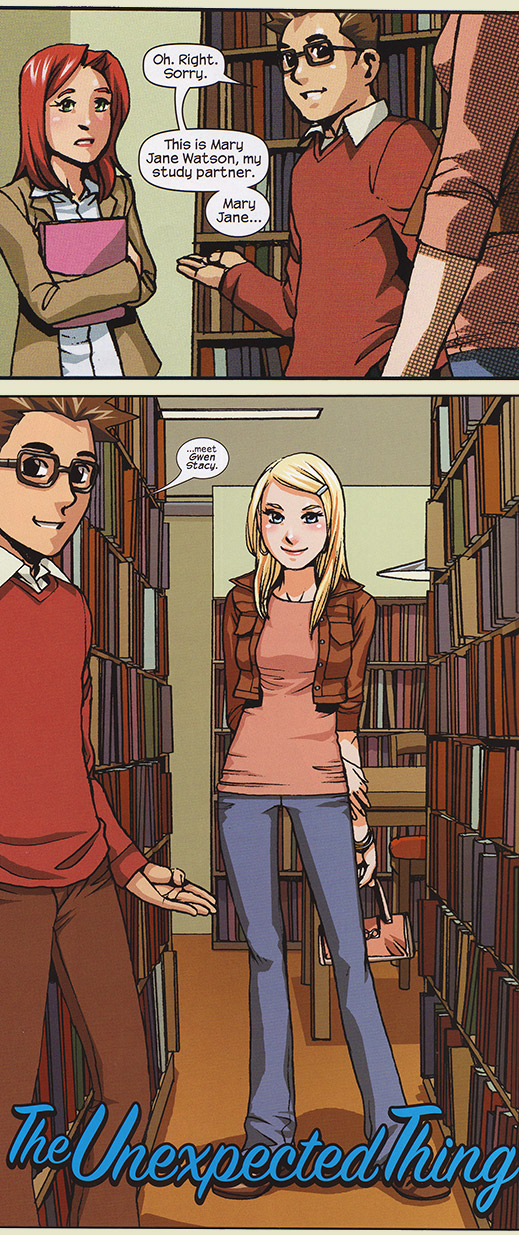 Oh Snap, Mary Jane! Time to step up your game!
Oh Snap, Mary Jane! Time to step up your game!
Spider-Man Loves Mary Jane absolutely sparkles. It's the most fun I'd had on a Spider-Man book in ages. Maybe ever.11 I've read the original series up through Gwen Stacy's exit, picked up again with the introduction of the Hobgoblin in the John Romita Junior days, exited again with the introduction of Carnage, picked up some of John Byrne's run and some Tangled Web, and hopped on again for volume 2 of Amazing Spider-Man (written by Howard Mackie and then by Michael J. Straczynsky) before exiting for good and forever after the "Sins Past" arc—because why on earth would anyone stay after that? There were some good stories in there (like "Kraven's Last Hunt" and the Aunt May Figures It Out episode), but none were particularly fun. Spider-Man Loves Mary Jane isn't concerned with just how depressing Peter Parker's life is (which is, of course, the overwhelmingly resilient vibe I get from my accumulated contact with the original series), partially because it isn't really even about Spider-Man. At least not at first.
Mary Jane Watson is a popular girl. She's good-looking, fun, buoyant, and has a fair amount of cross-over appeal in her school—making nice with kids from multiple walks of life. She's the lynchpin fourth to a trio of popular friends: wealthy flirt, Harry Osborn; quarterback of the varsity football squad, Flash Thompson; and Liz Allen, head cheerleader and Flash's verbally abusive girlfriend. Mary Jane's got a good good life, but nothing's perfect. Her friends want her to hook up with Harry because they're basically made for each other, but she's actually incapable of generating any real romantic interest because her heart belongs to a celebrity that she doesn't even know: Spider-Man.
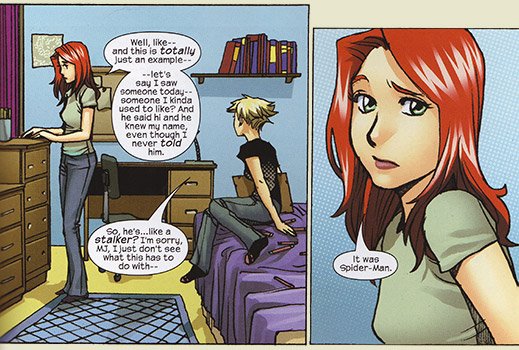
For much of the narrative, the hero occupies only the small dark corners of Mary Jane's story. He's not the main character, after all; just the MacGuffin. This is really and truly Mary Jane's story—at least for the first several arcs, after which Peter Parker's romantic drama begins insinuating itself into the narrative and we start getting more scenes with no Mary Jane. But that's all pretty late-in-game for the book's lifespan and one's never sure if that creeps in as the book gradually distracts from its raison d'etre or if the shift was editorially mandated.22It's easy to suspect the latter, as the book goes from being simply titled Mary Jane to shoehorning in Parker even above the heroine with Spider-Man Loves Mary Jane. The title shift always grated on me a bit, 1) for making Spider-Man the headliner of another character's story, but also 2) for insisting that Spider-Man loves Mary Jane rather than vice versa, stripping the book of any real tension, since no matter who Peter's dating, you are told explicitly by the title that he loves Mary Jane. Simultaneously, her love of Spider-Man is never at stake because the entire book is predicated on her obsession for the hero.
Spider-Man Loves Mary Jane is foremost the story of a young woman who cannot interact with reality in any kind of healthy way, hiding her existential dissonance from friends and acquaintances by a mask of effervescence. Even to her closest friend, the one who sees the cracks, she demurs, pretending that her fears, insecurities, and obsessions are perfectly within normal parameters. It's a balancing act that constantly threatens to overwhelm her, and minor breakdowns pepper the script from start to finish.
One of the early geniuses of the book is that McKeever writes Spider-Man as the problem rather than the solution.33Or at least a very visible symptom of the problem. If Mary Jane ever succeeds in her quest to win Spider-Man's love and affection, she will have lost her soul (so to speak). And Peter (a.k.a. Spider-Man), who titularly loves her, does not help her. He encourages her fracture from reality by making the fantasy more realistic. Beyond just flirting with Mary Jane while in costume, Peter at one point even takes Mary jane on a Spider-date. Peter's more concerned with his own needs than he is with Mary Jane's—because he's got his own issues with reality and his own problems with coping in the social circuit.
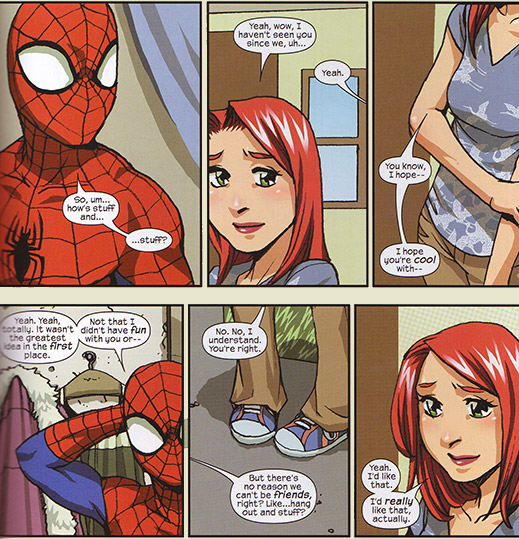 You guys are both blackholes of existential angst and you don't even know it.
You guys are both blackholes of existential angst and you don't even know it.
This is part of the joy of McKeever's version of the highschool Spider-verse: it plays as standard teen drama, but every last character is a psychological mess for their own discrete reasons. Which makes sense when you consider his prior work, The Waiting Place, which features the exact same kind of character complexity. I mentioned earlier that this incarnation of the Spider-Man mythos is perhaps the one I enjoy the most, the one that's the most fun. Though a series of characters each with their own social disaffections doesn't necessarily sound very buoyant at first, it's the combination of these characters' unique social disabilities that make them such a charming collection of personalities.
Takeshi Miyazawa, for his part, makes these dour-ish44Sort of not a fair description since McKeever gives the kids a good deposit of lively, humourous dialogue to fill in the crevasses of angst, woe, and social disability. kinds of interactions sparkly. His drawings of teens have always held a certain verve and energy that very few artists in the superhero field seem able to muster or imagine. He's great with expression and posture, but more than most Marvel artists Miyazawa seems to get clothing—and gives his characters a wide range of teen-ish fashion choices. His figures always seem believable and lively. I'm actively broken-hearted that we don't get to see more of his work.
Another contributor who turns the book into something more than just a second-tier effort on one of Marvel's little side books is Christina Strain, the colourist. Beyond just using a lot of screentones to texture the art, Strain does pretty phenomenal work translating Miyzawa's teens into something actually resemblant of the real world. More than merely providing a variety of colours on their fashion, Strain gives the kids' clothing patterns, graphics, and embroidery. It's an understated effect but it goes yards toward establishing them as real people. Here's a sample of just three of the hundreds of examples in these volumes.
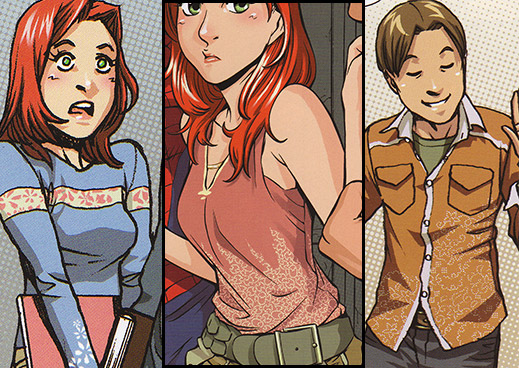
And if there's any question of Miyazawa's command over the book, everything kind of falls apart when he's not at the artistic helm. Early in the fourth arc he takes a break during a flashback chapter to be covered by Valentine de Landro, and the book falters substantially in those two chapters. Later, Miyazawa ultimately bids farewell to the book entirely (save for remaining on covers), handing the reins over to David Hahn, and again the book loses substantial steam. And it's not that Hahn is in any way a bad artist. He's pretty great actually and I loved his work on Private Beach. Hahn successfully draws a despondent Firestar, a frustrated Flash Thompson, a wily Felicia Hardy, whatever. He does just fine. The only problem is that he's following the firestorm of Miyazawa's tenure on the book and he'd have to do something downright incredible to not be second best here.55Actually, the only Marvel/DC artist I can think of who could have been a suitable replacement for Miyazawa is Stuart Immonen in his Nextwave/Never As Bad As You Think phase. It would have been different but would have also been distinct enough to reinvent the book while retaining some of Miyazawa's stylistic energy. Expanding beyond Marvel/DC artists, the only other artist I could see succeeding is Yoshitoki Oima (creator of A Silent Voice). She'd probably even be a more solid choice than Immonen, really.
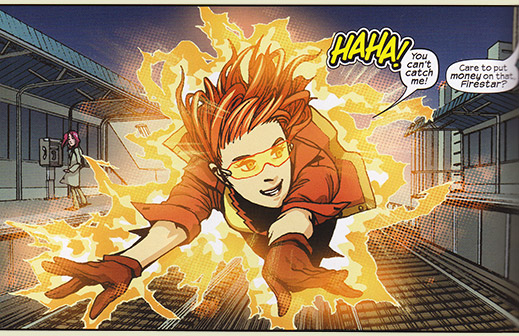 Hey, look! An occasional superhero!
Hey, look! An occasional superhero!
And unfortunately, David Hahn never had the chance to make the book his own. Spider-Man Loves Mary Jane folded with the close of the sixth act. I don't know whether McKeever had hoped to end it here exactly (as there are a couple unresolved bits), but he does a fair enough job. Nobody really gets over their problems; and Mary Jane, while somewhat bottoming out, doesn't seem to have had the ultimate kind of revelation that we can trust will keep her from the kind of disassociation that makes her celebrity fantasies at the book's start possible. McKeever leaves the toys in place for a future writer66Which is exactly the kind of thing that pushed me to abandon Marvel/DC books about eight years ago. If all stories have to circle back to the beginning, then they really aren't much stories at all, just narrative tricks—and seeing the same trick played over and again for years upon years just gets plain dulling., so it's no surprise I guess that Marvel revamped the series a year after it folded, headed by Strangers in Paradise creator Terry Moore.77The revamp, unfortunately, has essentially no relation to the prior series. Characters behave in wildly different manner and are now first-day sophomores in highschool rather than the juniors or seniors they were previously. The second series may or may not be fine—I haven't been able to give it a fair shot due to my investment in McKeever and Miyazawa's vision for the story.
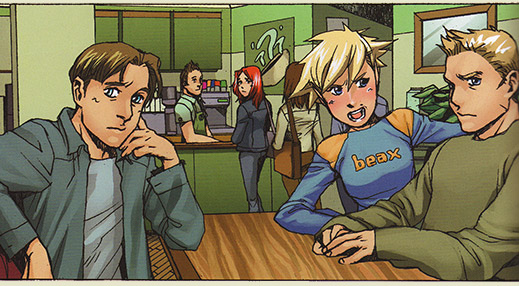 Miyazawa draws the four friends hanging at the coffee shop.
Miyazawa draws the four friends hanging at the coffee shop.
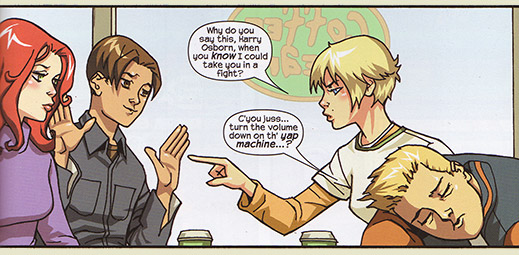 The same quartet under David Hahn's pen.
The same quartet under David Hahn's pen.
As time goes by, it's going to be increasingly difficult to get ahold of this series from the mid-Aughts, so if you're interested, get on your ball! I really do pretty highly recommend it for fans of the admixture of superheroing and romantic drama. It's lovely and lively and a testament to the fact that these old stories aren't entirely impossible to re-envigourate—if only creators can fashion something new and fancy from the wasted old bones of canon material.
Good Ok Bad features reviews of comics, graphic novels, manga, et cetera using a rare and auspicious three-star rating system. Point systems are notoriously fiddly, so here it's been pared down to three simple possibilities:
3 Stars = Good
2 Stars = Ok
1 Star = Bad
I am Seth T. Hahne and these are my reviews.
Browse Reviews By
Other Features
- Best Books of the Year:
- Top 50 of 2024
- Top 50 of 2023
- Top 100 of 2020-22
- Top 75 of 2019
- Top 50 of 2018
- Top 75 of 2017
- Top 75 of 2016
- Top 75 of 2015
- Top 75 of 2014
- Top 35 of 2013
- Top 25 of 2012
- Top 10 of 2011
- Popular Sections:
- All-Time Top 500
- All the Boardgames I've Played
- All the Anime Series I've Seen
- All the Animated Films I've Seen
- Top 75 by Female Creators
- Kids Recommendations
- What I Read: A Reading Log
- Other Features:
- Bookclub Study Guides









